Oct 9, 2019
No katsuo no life: appetite for bonito unbound in Kochi, Japan
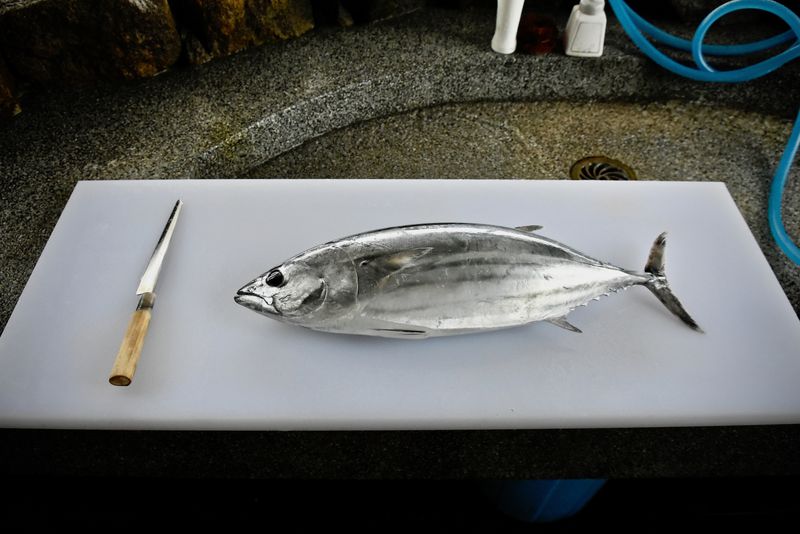
Watching Kazuhito Hayashi take to the task of cutting up our bonito (Japanese - “katsuo”) is almost hypnotic -- a display of rhythmic yet brutal blade-work efficiency that belies the charming smile of the man, an expression of his enthusiasm for preparing and serving katsuo no tataki, or seared bonito.
Like any good hypnotist though, Hayashi wields the power to snap his subjects out of their trance, and in this case (and for this subject) he does so by gleefully holding aloft the fish’s heart which he has so deftly removed.
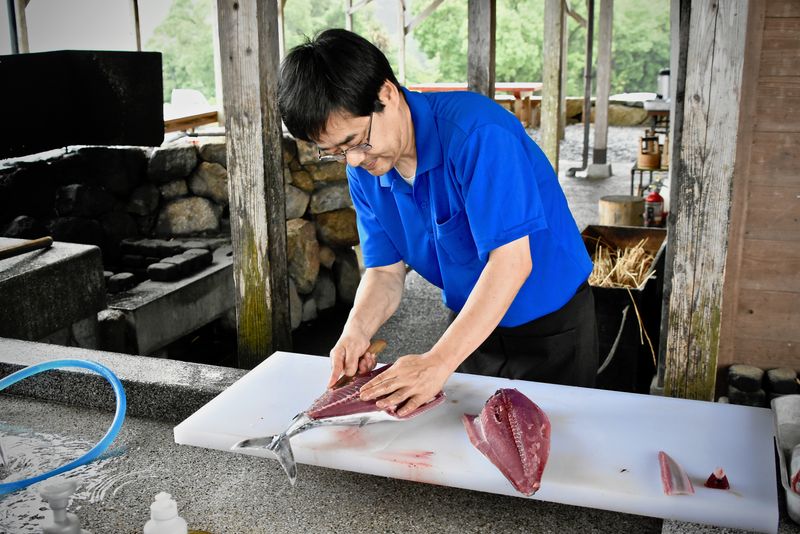
(Kazuhito Hayashi prepares katsuo for warayaki tataki in Nakatosa Town, Kochi Prefecture)
We’re in Japan’s bonito country, Kochi Prefecture, on the smallest of the country’s main islands, Shikoku. And we’ve reached its heart, literally and figuratively, here in Nakatosa Town.
Like Hayashi taking us through the steps to prepare katsuo no tataki, Kochi Prefecture’s enthusiasm for all-things bonito (the fish also known as skipjack tuna) appears unbridled. Bonito maintains a kind of rock star status as a promotional pin-up for the region, rivaled only by Meiji-era reformer and current-era high-school student idol Sakamoto Ryoma.
In downtown Kochi City, our port of entry to the region, images of bonito adorn manhole covers, oversized models of the fish jump out of restaurant and shop fronts, and Hello Kitty emerges from the fish’s mouth attached to the end of the keychain.
And that’s just the form you can’t eat. According to the Japan External Trade Organization (JETRO) Kochi, per-capita consumption of bonito in Kochi is the highest in Japan.
So the fishermen here in Nakatosa have got their work cut out then and it’s not because of a lack of fish -- populations of bonito are said to be quite sustainable. Rather, it’s because the bonito are caught using the “ipponzuri” method, plucked out of the north-flowing, life-giving Kuroshio black current one at a time by pole-and-line fishing, rather than the use of more conventional nets.
According to JETRO Kochi this method of fishing for bonito is an environment-and-resource conscious practice, even if it does sound Sisyphean. And here’s the bit you may not like, the fish are frozen alive. It means they “look better.”
Well, they certainly looked good on our first encounter with them, served up seared as katsuo no tataki in an elaborate collage of nibbles at a swanky izakaya in downtown Kochi where this reporter was on duty as part of a press pack in town to cover celebrity and snacks.
Any enthusiasm for the task of catching bonito was likely put to the test on the day of our arrival in Nakatosa though, with a looming typhoon churning up the waters and cloaking the skies in brooding grey clouds.
Still, a limited catch was delivered to us, and their new owner, at the Kure Taishomachi Market in the town’s Kure district, who enthusiastically handed us a pair of gloves so that we might have a go at handling the catch. Heavier than this handler expected.
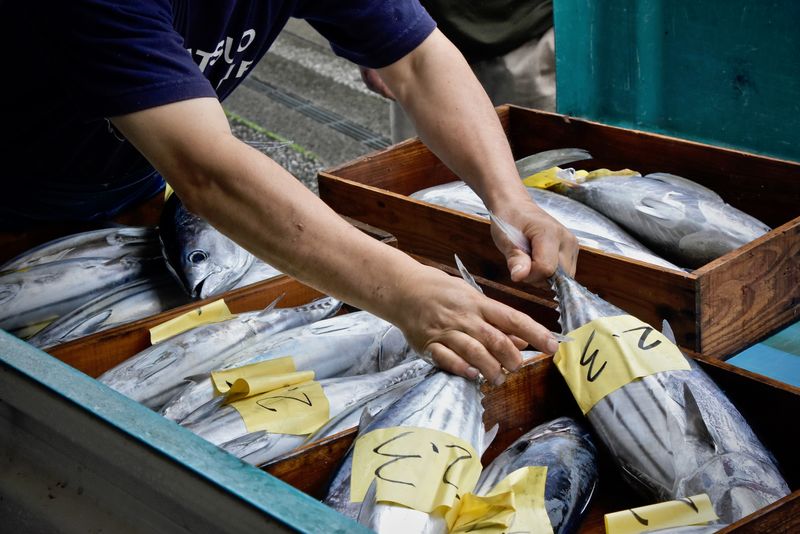
(The day's catch of katsuo delivered to Kure Taishomachi Market, Nakatosa Town, Kochi Prefecture)
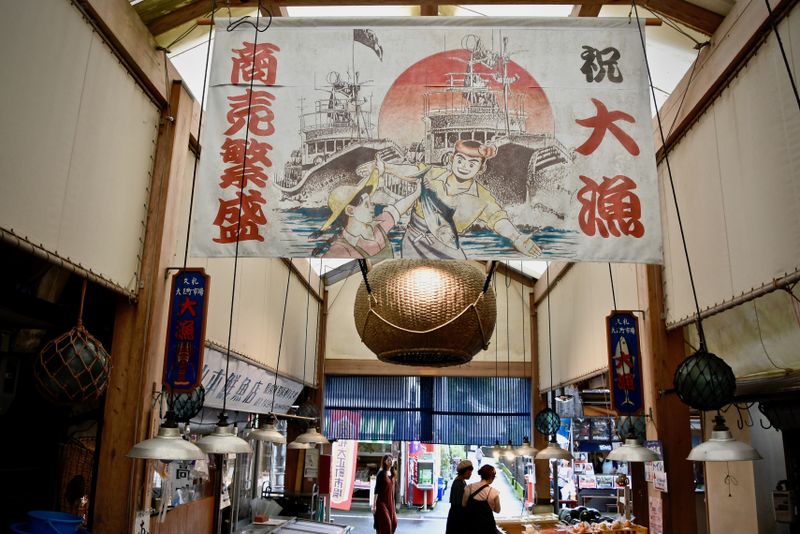
(Kure Taishomachi Market, Nakatosa Town, Kochi Prefecture)
Two young female guides sporting t-shirts that read “No Katsuo No Life” and a booming enthusiasm toward our presence (“You’re interested in that?” gasped one after spotting me taking a picture of a rustic alley sneaking out of the side of the market) told us that Kure Taishomachi Market has been used as a “local kitchen” by residents of Nakatosa since the Meiji Period.

The small covered market, a little sleepy courtesy of the lingering typhoon keeping people shuttered indoors, serves as the point-of-sale for local fruit and veg, and the day’s catch in these parts. It’s also a treasure trove of locally made trinkets and at one point we were handed a toothpick that was once a part of the skeletal structure of our bonito.
At the market’s Hama-chan restaurant we purchased sets of tickets to exchange at the market stalls for plates of sashimi and skewers of grilled, fatty katsuo haranbo and brought them back to the restaurant to eat along with steaming bowls of rice and miso soup.
Perhaps the bonito’s most wide-spread application in Japan is in the form of katsuobushi -- bonito dried, fermented, smoked and presented as pungent flakes -- which, when not dancing on freshly served dishes across the nation’s tables, forms one of the key ingredients of dashi stock, itself a pillar of Japanese cooking.
Ice cream then, might seem to be one of the bonito’s more unlikely applications. But then this is Japan, a country that seems to recognize few boundaries when it comes to matters of taste, particularly when it pertains to a light snack.
Michi no Eki Nakatosa sits across the road from the waters of Kure Bay south of Nakatosa Town. The modern facility which opened in July 2017 combines shopping, eating and amusement under the moniker, “SEA Project” and as a set up offers a shiny, straight-edged contrast to the faded charms of the nearby Kure Taishomachi Market.
The facility manager, a young man whose bronzed tan suggested that they do see plenty of sun in these parts despite the unrelenting typhoon greys that have perma-colored our trip, points us in the direction of the latest take on our bonito -- the “katsuo soft cream” -- soft ice cream containing katsuo dashi (giving it an off-white, almost beige color) topped with katsuobushi flakes.
Of course I tried one. Sheltering myself from the approaching typhoon rain (and the katsuobushi flakes from the approaching typhoon winds) I tucked into that thing with the kind of reluctance that one might when one’s ice cream comes flavored with fish.
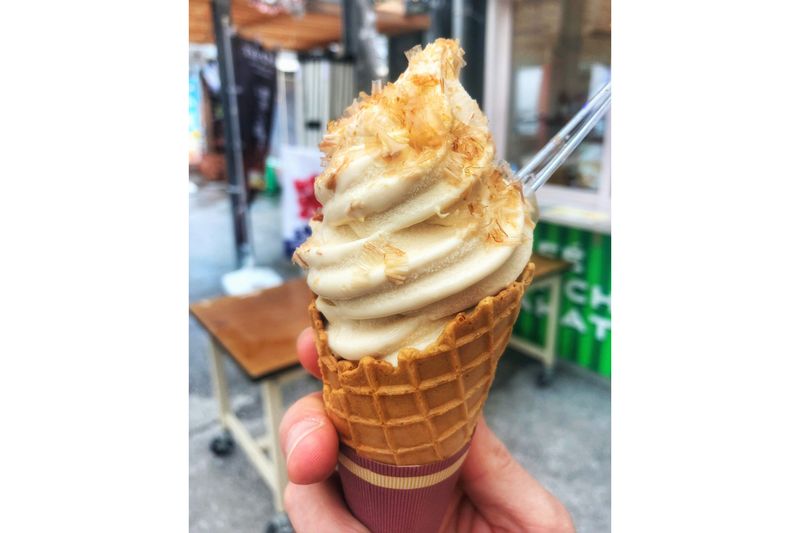
(Katsuo soft cream, Michi no Eki Nakatosa, Kochi Prefecture)
A member of our press-tour party sat across from me and stared. Feeling like she was waiting for a verdict I muttered something about it not being as horrible as I expected. (Actually, the salty flakes had the potential to contrast well with the smooth ice cream, were the cream itself not loaded with katsuo.)
She continued to stare. Was I eating it wrong? Is my gob covered in fish fakes?
I wanted to offer her some but was worried she might find the suggestion of strangers swapping saliva over a cone of ice cream a little too personal, even in the reportage of new experience. She continued to stare though, so I made the offer.
And she accepted it, totally none-plussed as she took a lippy bite. Her reaction was similar to mine, “Meh, not terrible.”
If bonito crowbarred into ice-cream smacks of marketing gimmick, then Kazuhito Hayashi appears as the salt-of-the-earth authentic counterpart.
We’re outside his Kuroshio Kobo restaurant which sits on a bluff overlooking the bay south of Nakatosa Town and Hayashi is preparing our bonito ready for us to have a go at searing it over open flames.
Hayashi’s short blade is making light work of our fish.
“When it comes to bonito, a fish up to 6kg is fine but any larger than that and it starts to lose its taste,” he explains as he lops off the head, guts the body, skins it, and slices the fish into five large strips which we are to take it in turns to grill.
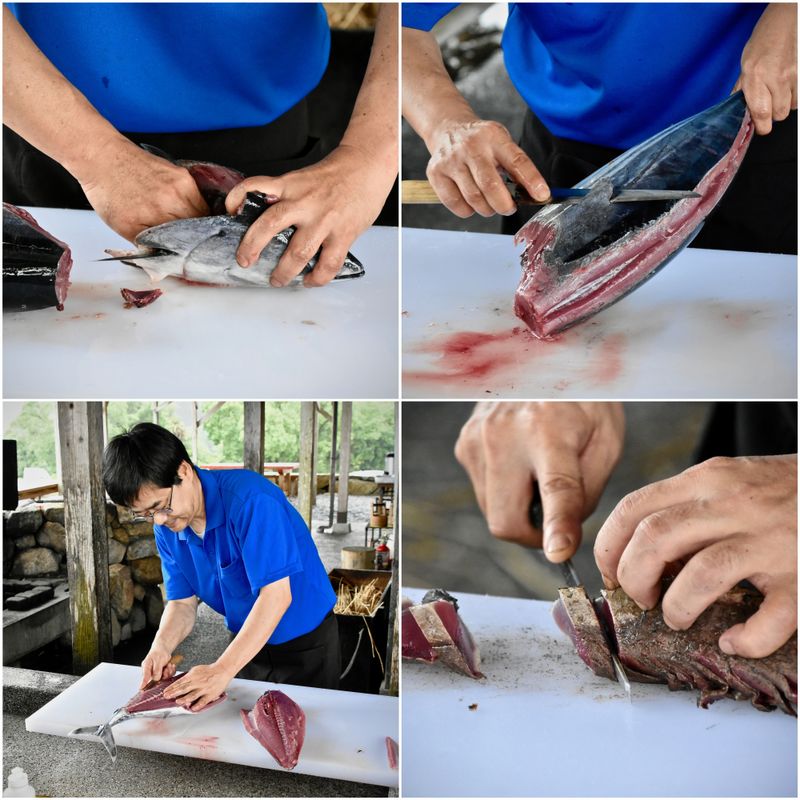
(Preparing katsuo at Kuroshio Kobo restaurant, Nakatosa Town, Kochi Prefecture)
The grilling process is called “warayaki tataki” and involves holding the cut of bonito over the base of wild flames licking out of their wara grass source, dry straw which Hayashi purchases from Nagano Prefecture. The holding implement in this case is something resembling a long gardening fork, the “fork” replaced by a grill sheet.
“The key is not to grill it for too long,” says Hayashi. Which is good, because fish and grilling implement weigh a tonne and even standing a few feet away from the flames the heat is intense.
The grass burns quickly, only enough to do one side of the fish, so Hayashi replaces it and we sear the other side of our bonito.
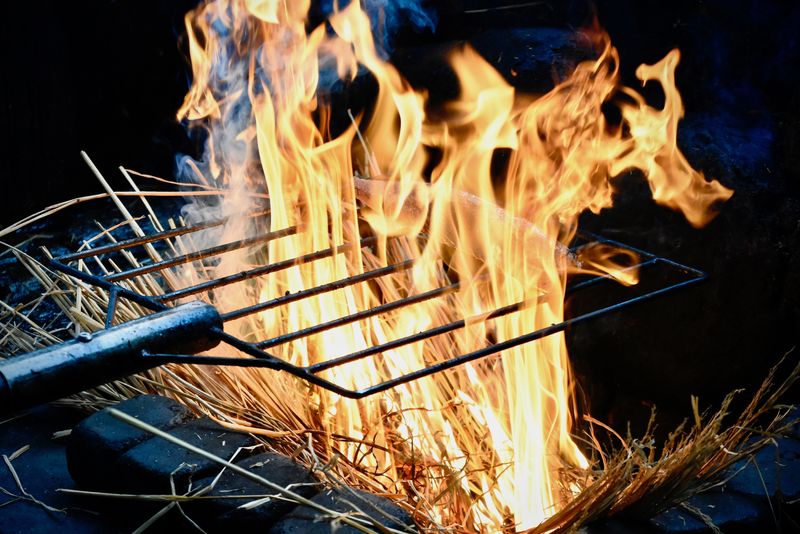
(Warayaki tataki katsuo experience, Kuroshio Kobo restaurant, Nakatosa Town, Kochi Prefecture)
Our five pieces appropriately seared and smoking Hayashi slices them vertically and places them on a bed of sliced onion with a side of finely sliced garlic and negi.
Inside the airy, wooden interior of the restaurant Hayashi recommends we first try one piece of the seared katsuo without any toppings or sauce, “to get a sense of the flavor.”
After that, it’s a free-for-all as we make steady work of the large board of katsuo, drizzling pieces with ponzu, others with yuzu citrus juice.
All the while, Hayashi talks shop, showing us his collection of blades and pointing us to the attic where he stores the wara grass, raising it off the floor to keep it dry (surely a tricky business given the amount of rain that falls in these parts -- a fair amount of it today, it seems).
“Sometimes there are shortages,” he tells us of the grass that gives the katsuo a unique taste and smell.
Shortages of wara maybe but there is no shortage of the katsuo being placed in front of us by Hayashi whose unbound enthusiasm motivates us to keep eating and would appear to reflect the mood of the people in these parts toward their pin-up fish.
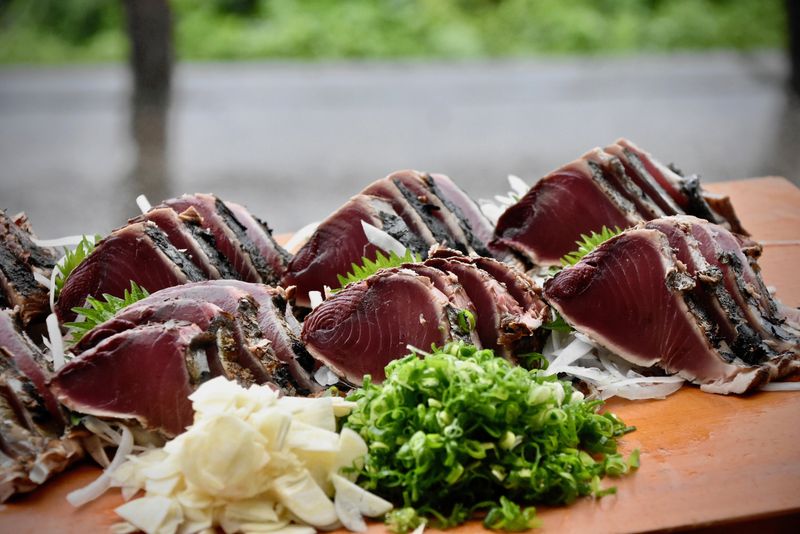
Reference:
Kure Taishomachi Market
6372-1 Kure, Nakatosa, Takaoka District, Kochi
Web (Japanese): http://xn--3iqz5v2uac6ljot32netg.com/
Michi no Eki Nakatosa (道の駅中土佐)
8645ー2 Kure, Nakatosa, Takaoka District, Kochi
Web (Japanese): https://www.nakatosa.com/
Kuroshio Kobo restaurant / warayaki experience
8009-11 Kure, Nakatosa, Takaoka District, Kochi



0 Comments